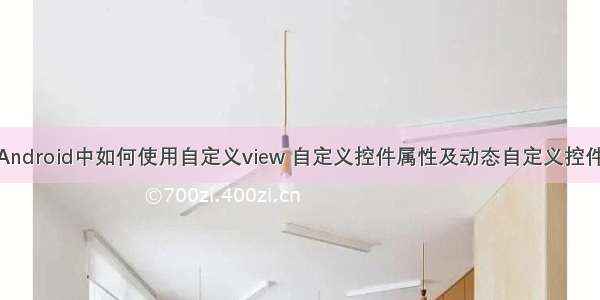
先总结下自定义View的步骤:
1、自定义View的属性
2、在View的构造方法中获得我们自定义的属性
[ 3、重写onMesure ]
4、重写onDraw
我把3用[]标出了,所以说3不一定是必须的,当然了大部分情况下还是需要重写的。
具体理解参考:/lmj623565791/article/details/24252901/
<?xml version="1.0" encoding="utf-8"?><resources><!-- 自定义属性名和属性类型 --><attr name="text" format="string"/><attr name="textcolor" format="color"/><attr name="textsize" format="dimension"/><!-- 声明属性 --><declare-styleable name="customview03_attrs"><attr name="text"></attr><attr name="textcolor"></attr><attr name="textsize"></attr></declare-styleable></resources>
<RelativeLayout xmlns:android="/apk/res/android"xmlns:tools="/tools" xmlns:tuke="/apk/res/com.example.customview03" android:layout_width="match_parent"android:layout_height="match_parent" ><com.example.customview03.CustomView03 android:id="@+id/view03"android:layout_width="wrap_content"android:layout_height="wrap_content"android:padding="20dp"tuke:text="4327"tuke:textcolor="#ff0000"tuke:textsize="40sp"/><!-- 对于继承的view没有的属性,可以使用自定义属性,加命名空间 --></RelativeLayout>
CustomView03.java
/*** */package com.example.customview03;import java.util.HashSet;import java.util.Random;import java.util.Set;import android.R.integer;import android.content.Context;import android.content.res.TypedArray;import android.graphics.Canvas;import android.graphics.Color;import android.graphics.Paint;import android.graphics.Rect;import android.util.AttributeSet;import android.view.View;import android.view.View.MeasureSpec;import android.widget.TextView;/*** @author tuke**/public class CustomView03 extends View {String text;int textcolor;int textsize;/***绘制时控制文本绘制的范围*/private Rect mBound;private Paint mPaint;public CustomView03(Context context) {this(context,null);// 代码初始化调用的构造函数}public CustomView03(Context context, AttributeSet attrs) {this(context, attrs,0);// xml文件初始化调用的构造函数}public CustomView03(Context context, AttributeSet attrs, int defStyleAttr) {super(context, attrs, defStyleAttr);// xml文件初始化调用的构造函数,获得我们所定义的自定义样式属性,类型数组,把自定义属性存放到当地变量TypedArray array=context.getTheme().obtainStyledAttributes(attrs, R.styleable.customview03_attrs, defStyleAttr, 0);int count=array.getIndexCount();for(int i=0;i<count;i++){int index=array.getIndex(i);switch (index) {case R.styleable.customview03_attrs_text:text=array.getString(index);break;case R.styleable.customview03_attrs_textcolor:textcolor=array.getInt(index, Color.BLACK);break;case R.styleable.customview03_attrs_textsize:textsize=array.getDimensionPixelSize(index, 16);break;default:break;}}array.recycle();//typearray要回收// 获得绘制文本的宽和高 mPaint=new Paint();mPaint.setTextSize(textsize);mBound = new Rect();mPaint.getTextBounds(text, 0, text.length(), mBound);this.setOnClickListener(new OnClickListener() {@Overridepublic void onClick(View v) {text=getRamdomText();postInvalidate();}});}//获得随机4位数private String getRamdomText(){Random random = new Random();Set<Integer> set = new HashSet<Integer>();while (set.size() < 4){int randomInt = random.nextInt(10);set.add(randomInt);}StringBuffer sb = new StringBuffer();for (Integer i : set){sb.append("" + i);}return sb.toString();}@Overrideprotected void onMeasure(int widthMeasureSpec, int heightMeasureSpec){//super.onMeasure(widthMeasureSpec, heightMeasureSpec);//xml中设置为wrap_content的话,系统测量会是满屏/** 注意:* 重写之前先了解MeasureSpec的specMode,一共三种类型:* EXACTLY:一般是设置了布局文件设置的是明确的值或者是MATCH_PARENT* AT_MOST:表示子布局限制在一个最大值内,一般为WARP_CONTENT* UNSPECIFIED:表示子布局想要多大就多大,很少使用* 因为正是不知道内容大小才去测量* */int width=0,height=0;//测量宽int specMode=MeasureSpec.getMode(widthMeasureSpec);int specSize=MeasureSpec.getSize(widthMeasureSpec);//主要是得到View的内容的宽度switch (specMode){case MeasureSpec.EXACTLY://1073741824width = getPaddingLeft() + getPaddingRight() + specSize;//内容的宽度+内边距=View的宽度break;case MeasureSpec.AT_MOST://-2147483648width = getPaddingLeft() + getPaddingRight() + mBound.width();break;}//测量高specMode = MeasureSpec.getMode(heightMeasureSpec);specSize = MeasureSpec.getSize(heightMeasureSpec);//主要是得到View的内容的高度switch (specMode){case MeasureSpec.EXACTLY:height = getPaddingTop() + getPaddingBottom() + specSize;//内容的高度+内边距=View的高度break;case MeasureSpec.AT_MOST:height = getPaddingTop() + getPaddingBottom() + mBound.height();break;}//这个方法在OnMesure中必须被调用,来存储已经测量的宽和高setMeasuredDimension(width, height);}@Overrideprotected void onDraw(Canvas canvas){mPaint.setColor(Color.YELLOW);canvas.drawRect(0, 0, getWidth(), getHeight(), mPaint);mPaint.setColor(Color.BLACK);for(int i=0;i<400;i++){Random randomx=new Random();int rx=randomx.nextInt(getWidth());int ry=randomx.nextInt(getHeight());canvas.drawCircle(rx, ry, 3, mPaint);}mPaint.setColor(textcolor);canvas.drawText(text, getWidth() / 2 - mBound.width() / 2, getHeight() / 2 + mBound.height() / 2, mPaint);}}
关于自定义属性
1,先定义属性文件attrs.xml
<?xml version="1.0" encoding="utf-8"?><resources><declare-styleable name="myView"> <attr name="textColor" format="color"/> <attr name="textSize" format="dimension"/> </declare-styleable></resources>
2,在布局文件中加入自定义属性,加上命名空间
<?xml version="1.0" encoding="utf-8"?> <LinearLayout xmlns:android="/apk/res/android" xmlns:test="/apk/res/com.example.customview04" android:orientation="vertical" android:layout_width="fill_parent" android:layout_height="fill_parent" > <TextView android:layout_width="fill_parent" android:layout_height="wrap_content" android:text="helloworld" /> <com.example.customview04.CustomView04android:layout_width="fill_parent" android:layout_height="fill_parent" test:textSize="10px" test:textColor="#fff" /> <!-- test是命名空间 --></LinearLayout>
3,在自定义View的构造函数中通过TypedArray获取自定义属性值
package com.example.customview04;import android.content.Context;import android.content.res.TypedArray;import android.graphics.Canvas;import android.graphics.Color;import android.graphics.Paint;import android.graphics.Paint.Style;import android.graphics.Rect;import android.util.AttributeSet;import android.view.View;public class CustomView04 extends View {private Paint myPaint; private static final String myString = "Welcome to our Zoon!"; public CustomView04(Context context) { super(context); // TODO Auto-generated constructor stub } public CustomView04(Context context, AttributeSet attr) { super(context, attr); myPaint = new Paint(); //获取自定义的属性TypedArray a = context.obtainStyledAttributes(attr, R.styleable.myView);//TypedArray是一个数组容器 float textSize = a.getDimension(R.styleable.myView_textSize, 30);//防止在XML文件里没有定义,就加上了默认值30 int textColor = a.getColor(R.styleable.myView_textColor, 0xFFFFFFFF);//同上,这里的属性是:名字_属性名 myPaint.setTextSize(textSize); myPaint.setColor(textColor); a.recycle();//我的理解是:返回以前取回的属性,供以后使用。以前取回的可能就是textSize和textColor初始化的那段 } @Override protected void onDraw(Canvas canvas) { // TODO Auto-generated method stub super.onDraw(canvas); //myPaint = new Paint(); myPaint.setColor(Color.RED); myPaint.setStyle(Style.FILL); canvas.drawRect(new Rect(10,10,100,100), myPaint); myPaint.setColor(Color.WHITE); canvas.drawText(myString, 10, 100, myPaint); } }
关于TypedArray和AttributeSet
AttributeSet的作用就是在控件进行初始化的时候,解析布局文件中该控件的属性(keyeg:background)与该值(valueeg:@drawable/icon)的信息封装在AttributeSet中,传递给该控件(View)的构造函数。
对于非Android自带的属性,在View类中处理时是无法识别的,因此需要我们自己解析。所以这就要用到另外一个类TypedArray。在AttributeSet中我们有属性名称,有属性值,但是控件如何知道哪个属性代表什么意思呢?这个工作就由TypedArray来做了。
TypedArray对象封装了/values/attrs.xml中的styleable里定义的每个属性的类型信息,通过TypedArray我们就可以知道AttributeSet中封装的值到底是干什么的了,从而可以对这些数据进行应用。
具体理解参考/lmj623565791/article/details/45022631/
















